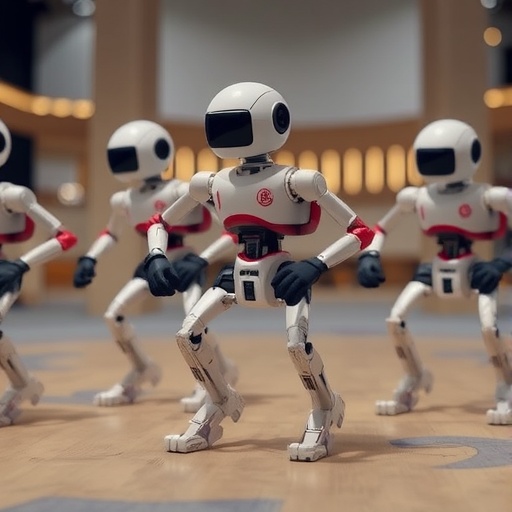In a groundbreaking advancement in the field of robotics, researchers from the University of Oxford have unveiled a novel class of soft robots that operate autonomously, relying solely on air pressure rather than traditional electronic components. This innovative approach could revolutionize how robots are designed and utilized, particularly in complex environments that require adaptability and efficiency. The collaborative research study, showcased in the esteemed journal Advanced Materials, highlights the development of what are termed “fluidic robots.” These creatures defy the conventional reliance on motors, sensors, and intricate programming, instead harnessing the potential of pneumatic actuation to create sophisticated, synchronized movements.
At the forefront of this research is Professor Antonio Forte, who leads the Robotics and Autonomous Systems Laboratory (RADLab) at the university. Forte emphasizes the significance of creating machines that can exhibit complex behaviors without conventional ‘brains.’ He notes that such a decentralized approach allows these robots to exploit their structural design to perform essential tasks, thereby freeing up cognitive resources for more intricate functions. The implications of this research reach far beyond the laboratory, potentially enabling robots to be deployed in scenarios ranging from search and rescue operations to delicate object manipulation in unpredictable settings.
The soft robotics domain is increasingly recognized for its applications in areas such as disaster response, agriculture, and healthcare. The creation of robots that can maneuver over challenging terrain or interact sensitively with their surroundings is paramount. However, one of the primary goals among researchers has been to encode not just physical movement but decision-making capabilities directly into a robot’s fabric, merging its operational design with an adaptive behavioral framework. This represents a significant departure from traditional electronic systems, which often necessitate elaborate programming and control mechanisms.
To tackle this notable challenge, the Oxford researchers drew inspiration from biological systems where components seamlessly coordinate actions. This study’s focal point is a small, prototypical module, functioning akin to a biological muscle, which employs air pressure to initiate mechanical movements while simultaneously sensing environmental changes. This multifunctional unit can act, sense, and switch airflow, creating a platform for a myriad of robotic configurations capable of executing diverse tasks with minimal external input.
The researchers designed these modular elements so that they can easily connect, similar to LEGO pieces. During testing, a series of these interconnected units formed robots capable of various movements—hopping, shaking, or crawling—demonstrating an impressive flexibility in design and function. In particular configurations, it was established that each unit could perform all three roles simultaneously, generating independent rhythmic movements merely through the application of continuous air pressure.
The mechanism behind the synchronization of these movements is particularly intriguing. When multiple units are linked and in contact with a surface, they begin to harmonize their actions without the need for prearranged instructions or electronic control. This phenomenon was elucidated through the employment of the Kuramoto model, which is well-regarded in the study of synchronized oscillators. The mathematical framework outlines how coordination can naturally arise from physical systems based purely on their inherent design and interaction with their surroundings.
Central to this emergent behavior is the interplay between the robotic limbs and the physical ground. As with natural phenomena, the patterns of motion in these robots arise not from a central processing unit but from the friction and forces they impart on one another through shared physical interactions. The design allows for spontaneous collective behavior, akin to the unanticipated synchronization seen in fireflies flashing in unison, a testament to nature’s efficiency and elegance in organizing independent entities.
From a practical standpoint, the present prototypes of these air-powered robots are at a scale suitable for tabletop applications. Still, the researchers convey optimism about scaling this technology for larger, untethered locomotion systems. These advancements could enable deployment in harsher environments where energy sources are limited, and robots must adapt to varied and challenging conditions without heavy reliance on traditional energy supplies.
The implications of developing robots capable of embodied intelligence reach far along the trajectory of robotic applications. By embedding the decision-making processes into the physical form and functionality of the robots themselves, researchers foresee a paradigm shift where machines could operate more autonomously and efficiently than their electronically controlled counterparts. This could lead to a new spectrum of robots that can engage more organically and responsively with the environments they navigate.
Professor Forte reaffirms this vision, suggesting that this project’s findings could signify a transition from traditional design paradigms in robotics. He envisions “robots that are their own brains,” indicating a future where machines can spontaneously adapt to circumstances, interact with their surroundings, and solve problems, all without needing complex programming or external input. The potential for such robots to revolutionize industries and enhance human-robot interactions is profound.
In conclusion, the groundbreaking work conducted by the University of Oxford’s research team marks a pivotal moment in robotics. By demonstrating that complex and autonomous behaviors can emerge from simple, decentralized systems powered by air pressure, this research encourages further exploration within the realm of soft robotics. Ultimately, the fusion of functional design and responsiveness could redefine our relationship with machines, elevating their capacities to unprecedented heights and unlocking new potentials in numerous critical fields.
Subject of Research: Soft Robots Utilizing Air Pressure
Article Title: Multifunctional Fluidic Units for Emergent, Responsive Robotic Behaviors
News Publication Date: November 5, 2025
Web References: University of Oxford
References: Advanced Materials, DOI: 10.1002/adma.202510298
Image Credits: Antonio Forte and Mostafa Mousa
Keywords
Soft robotics, Autonomous robots, Fluidic systems, Emergent behaviors, Modular robotics, Biomimetic design, Synchronized motion, Air-powered mechanisms, Responsive robotics, Engineering innovations.




